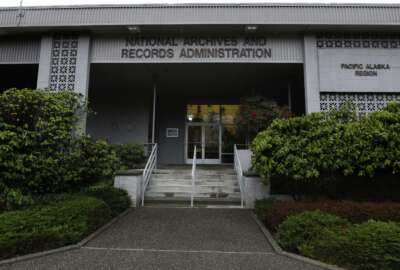Sponsored by Canon
How CBP got its records management program off NARA’s high risk list
Localizing oversight helped CBP bring its decentralized records management process into compliance with NARA's standards.
In 2017, the National Archives and Records Administration assessed Customs and Border Protection’s records management practices as being within the high-risk category. In 2022, the latest available report on the website, NARA’s assessment was 54 points higher, placing CBP firmly in the low-risk category. The key to that improvement, according to CBP Chief Records Officer Dawn Watts, was installing a localized records management structure of accountability in CBP’s 30 component offices.
“Every office has what we call an accountable executive that we go to for decision making and budget and resource needs. Every office has what we call our local records manager … that does the records management program within their area of responsibility,” Watts said on Federal Monthly Insights — Records Management. “And then there’s the boots on the ground, the records management custodians, within each of those offices that actually do the day to day handling of the records.”
CBP also did the same thing for compliance: Each component office now has its own internal self-assessment for compliance with NARA requirements that is identical to the one NARA uses to assess the agency as a whole. Both of those measures helped CBP get its largely decentralized records management program all on the same page.
That’s important because CBP as a whole generates more than 800 million records annually, Watts said, including 4.1 million emails daily. And those records have to be determined and preserved according to their type; only 1% of those records are permanent.
“Some records are considered temporary, but temporary encompasses 75 years of keeping those records. Some can be destroyed, and/or deleted after a matter of 30 days,” Watts said on the Federal Drive with Tom Temin. “If they’re intermediary records, then those records need to be kept for much, much shorter timeframes. So it really depends and runs the gamut based on the type of record and the business use of those records.”
Sometimes, though, CBP runs across a type of record that NARA doesn’t have a schedule for. When that happens, CBP has to work with NARA to create a new record schedule, which can take up to a year. Creating a new record schedule involves balancing privacy and security concerns with the public trust and interest.
That’s because the government also requires records to be accessible to the public whenever possible. Citizens can request them through the Freedom of Information Act, and CBP needs to be able to respond transparently.
Records also need to be created with inter-agency sharing in mind. CBP regularly interfaces with Immigration and Customs Enforcement, other Department of Homeland Security agencies, and other external agencies like the FBI. That’s facilitated by the fact that most records CBP creates are now digital-by-default.
“We do not create a whole lot of new paper at this point in time. But we still have the legacy customs, we still have pre-DHS, and there is still an amount of paper records out there that we deal with and we manage on a day to day basis. And part of that is the preservation of those records, making sure that those records don’t become in and of themselves obsolete because they are paper and or non-digital records,” Watts said. “So we primarily know that within CBP we’re creating forms, records and documents that are born electronic. So the paper records, the legacy records, we will be working with NARA to accession those in preparation for the new guidance that everything must be digitized after 30 June 2024.”
That doesn’t mean paper records aren’t still formed; recently, some records of border encounters still spawn paper records, Watts said. But they originate digitally. Watts said that in the case of paper records that do need to be preserved, CBP works with NARA to accession those, because NARA has the infrastructure to take on the majority of that burden. Watts said CBP is investing in some of those capabilities itself, and training its workforce to be able to respond to those situations when necessary. But primarily, the solution is to let NARA handle it.
And digitizing those records doesn’t just preserve them more securely for the future — it also makes them more secure and accessible.
“The preservation of a digital record is going to be much more secure than say, again, an older map, or an older piece of paper that was created on the thin non-modern paper format from today. So now part of NARA’s reasoning there is to make sure that we move in that direction; they’re forcing us to move in that direction for the preservation of records, on the one hand, but also just the sheer volume and space and … being able to access those records across the board,” Watts said. “You don’t have to go to a file cabinet to get something; it’s there, it’s available, it’s accessible, it’s transparent to the public. And it’s available for FOIA request or any type of inquiry that may come along.”
Copyright © 2025 Federal News Network. All rights reserved. This website is not intended for users located within the European Economic Area.
Daisy Thornton is Federal News Network’s digital managing editor. In addition to her editing responsibilities, she covers federal management, workforce and technology issues. She is also the commentary editor; email her your letters to the editor and pitches for contributed bylines.
Follow @dthorntonWFED






